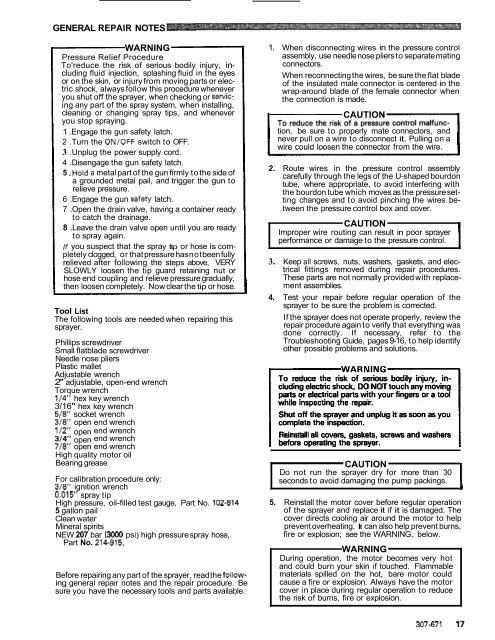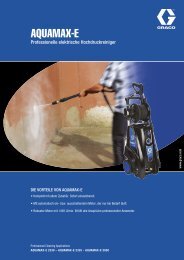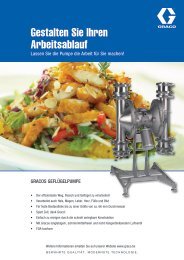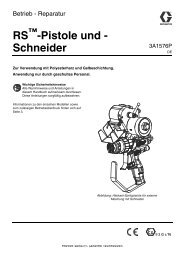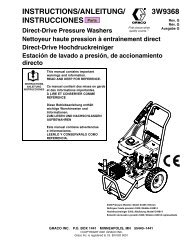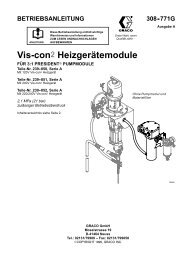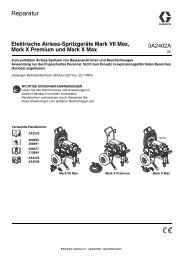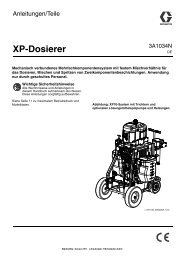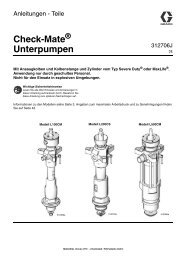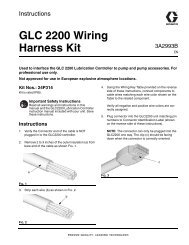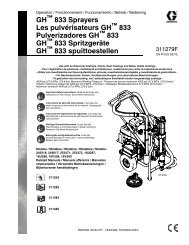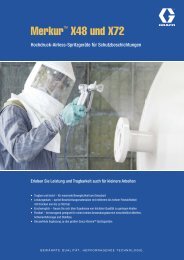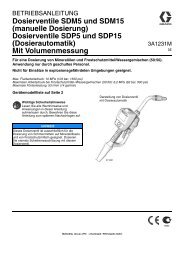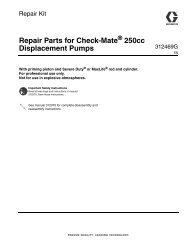307671D ULTRA 400 AIRLESS PAINT SPRAYER - Graco Inc.
307671D ULTRA 400 AIRLESS PAINT SPRAYER - Graco Inc.
307671D ULTRA 400 AIRLESS PAINT SPRAYER - Graco Inc.
You also want an ePaper? Increase the reach of your titles
YUMPU automatically turns print PDFs into web optimized ePapers that Google loves.
GENERAL REPAIR NOTES<br />
WARNING<br />
Pressure Relief Procedure<br />
To'reduce the risk of serious bodily injury, including<br />
fluid injection, splashing fluid in the eyes<br />
or on the skin, or injury from moving parts or electric<br />
shock, always follow this procedure whenever<br />
you shut off the sprayer, when checking or servic:<br />
ing any part of the spray system, when installing,<br />
cleaning or changing spray tips, and whenever<br />
you stop spraying.<br />
1 .Engage the gun safety latch.<br />
2 .Turn the ONIOFF switch to OFF.<br />
3 .Unplug the power supply cord.<br />
4 .Disengage the gun safety latch.<br />
5 .Hold a metal part of the gun firmly to the side of<br />
a grounded metal pail, and trigger the gun to<br />
relieve pressure.<br />
6 .Engage the gun safe& latch.<br />
7 .Open the drain valve, having a container ready<br />
to catch the drainage.<br />
8 .Leave the drain valve open until you are ready<br />
to spray again.<br />
If you suspect that the spray tip or hose is completely<br />
clogged, or that pressure has not been fully<br />
relieved after following the steps above, VERY<br />
SLOWLY loosen the tip guard retaining nut or<br />
hose end coupling and relieve pressure gradually,<br />
then loosen completely. Now clear the tip or hose.<br />
Tool List<br />
The following tools are needed when repairing this<br />
sprayer.<br />
Phillips screwdriver<br />
Small flatblade screwdriver<br />
Needle nose pliers<br />
Plastic mallet<br />
Adjustable wrench<br />
2" adjustable, open-end wrench<br />
Torque wrench<br />
114" hex key wrench<br />
3/16" hex key wrench<br />
518" socket wrench<br />
318" open end wrench<br />
112'' open end wrench<br />
314" open end wrench<br />
718" open end wrench<br />
High quality motor oil<br />
Bearing grease<br />
For calibration procedure only:<br />
318 ignition wrench<br />
0.015' spray tip<br />
High pressure, oil-filled test gauge, Part No. 102-814<br />
5 gallon pail<br />
Clean water<br />
Mineral spirits<br />
NEW 207 bar (3oM) psi) high pressure spray hose,<br />
Part No. 214-915.<br />
Before repairing any part of the sprayer, read the following<br />
general repair notes and the repair procedure. Be<br />
sure you have the necessary tools and parts available.<br />
1. When disconnecting wires in the pressure control<br />
assembly, use needle nose pliers to separate mating<br />
connectors.<br />
When reconnecting the wires, be sure the flat blade<br />
of the insulated male connector is centered in the<br />
wrap-around blade of the female connector when<br />
the connection is made.<br />
CAUTION<br />
tion, be sure to properly mate connectors, and<br />
never pull on a wire to disconnect it. Pulling on a<br />
wire could loosen the connector from the wire.<br />
2. Route wires in the pressure control assembly<br />
carefully through the legs of the U-shaped bourdon<br />
tube, where appropriate, to avoid interfering with<br />
the bourdon tube which moves as the pressure setting<br />
changes and to avoid pinching the wires between<br />
the pressure control box and cover.<br />
CAUTION<br />
Improper wire routing can result in poor sprayer<br />
performance or damage to the pressure control.<br />
3. Keep all screws, nuts, washers, gaskets, and electrical<br />
fittings removed during repair procedures.<br />
These parts are not normally provided with replacement<br />
assemblies.<br />
4. Test your repair before regular operation of the<br />
sprayer to be sure the problem is corrected.<br />
If the sprayer does not operate properly, review the<br />
repair procedure again to verify that everything was<br />
done correctly. If necessary, refer to the<br />
Troubleshooting Guide, pages 9-16, to help identify<br />
other possible problems and solutions.<br />
To reduce the risk of serious bodily injury, including<br />
electric shock, DO NOT touch any moving<br />
parts or electrical parts with your fingers or a tool<br />
while inspecting.the repair.<br />
Shut off the sprayer and unplug it as soon as you<br />
complete the inspection.<br />
Reinstall all covers, gaskets, screws and washers<br />
FW<br />
before operating the sprayer.<br />
CAUTION<br />
Do not run the sprayer dry for more than 30<br />
seconds to avoid damaging the pump packings.<br />
5. Reinstall the motor cover before regular operation<br />
of the sprayer and replace it if it is damaged. The<br />
cover directs cooling air around the motor to help<br />
prevent overheating. It can also help prevent burns,<br />
fire or explosion; see the WARNING, below.<br />
WARNING<br />
During operation, the motor becomes very hot<br />
and could burn your skin if touched. Flammable<br />
materials spilled on the hot, bare motor could<br />
cause a fire or explosion. Always have the motor<br />
cover in place during regular operation to reduce<br />
the risk of burns, fire or explosion.<br />
307-671 17


